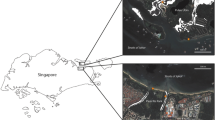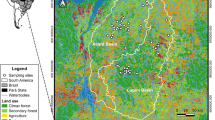Abstract
Mangrove forests in meso-tidal areas are completely drained during low tides, forming only temporary habitats for fish. We hypothesised that in such temporary habitats, where stranding risks are high, distance from tidal creeks that provided access to inundated areas during receding tides would be the primary determinant of fish distribution. Factors such as depth, root density and shade were hypothesised to have secondary effects. We tested these hypotheses in a tidally drained mangrove patch in the Andaman Islands, India. Using stake nets, we measured fish abundance and species richness relative to distance from creeks, root density/m2, shade, water depth and size (total length) of fish. We also predicted that larger fish (including potential predators) would be closer to creeks, as they faced a greater chance of mortality if stranded. Thus we conducted tethering trials to examine if predation would be greater close to the creeks. Generalised linear mixed effects models showed that fish abundance was negatively influenced by increasing creek distance interacting with fish size and positively influenced by depth. Quantile regression analysis showed that species richness was limited by increasing creek distance. Proportion of predation was greatest close to the creeks (0–25 m) and declined with increasing distance. Abundance was also low very close to the creeks, suggesting that close to the creeks predation pressure may be an important determinant of fish abundance. The overall pattern however indicates that access to permanently inundated areas, may be an important determinant of fish distribution in tidally drained mangrove forests.



Similar content being viewed by others
References
Adams AJ, Dahlgren CP, Kellison TG et al (2006) Nursery function of tropical back-reef systems. Mar Ecol Prog Ser 318:287–301. doi:10.3354/meps318287
Antony G, George JP, Mathew A et al (2005) Ichthyofauna of the mangrove ecosystem. Mangrove ecosystems: a manual for the assessment of biodiversity. CMFRI, Chennai, pp 83–116
Baker R, Sheaves M (2005) Redefining the piscivore assemblage of shallow estuarine nursery habitats. Mar Ecol Prog Ser 291:197–213
Baker R, Sheaves M (2009) Overlooked small and juvenile piscivores dominate shallow-water estuarine “refuges” in tropical Australia. Estuar Coast Shelf Sci 85:618–626. doi:10.1016/j.ecss.2009.10.006
Beck MW, Heck KL, Able KW et al (2001) The identification, conservation, and management of estuarine and marine nurseries for fish and invertebrates. Bioscience 51:633–641. doi:10.1641/0006-3568(2001)051[0633:TICAMO]2.0.CO;2
Blaber SJM, Milton DA (1990) Species composition, community structure and zoogeography of fishes of mangrove estuaries in the Solomon Islands. Mar Biol 105:259–267. doi:10.1007/bf01344295
Blaber SJM, Brewer DT, Salini JP (1995) Fish communities and the nursery role of the shallow inshore waters of a tropical bay in the gulf of Carpentaria, Australia. Estuar Coast Shelf Sci 40:177–193. doi:10.1016/s0272-7714(05)80004-6
Cade BS, Noon BR (2003) A gentle introduction to quantile regression for ecologists. Front Ecol Environ 1:412–420. doi:10.1890/1540-9295(2003)001[0412:AGITQR]2.0.CO;2
Chong VC, Sasekumar A, Leh MUC, D’Cruz R (1990) The fish and prawn communities of a Malaysian coastal mangrove system, with comparisons to adjacent mud flats and inshore waters. Estuar Coast Shelf Sci 31:703–722. doi:10.1016/0272-7714(90)90021-i
Cocheret de la Morinière E, Nagelkerken I, Meij H, Velde G (2004) What attracts juvenile coral reef fish to mangroves: habitat complexity or shade? Mar Biol 144:139–145. doi:10.1007/s00227-003-1167-8
Dorenbosch M, Grol MGG, de Groene A et al (2009) Piscivore assemblages and predation pressure affect relative safety of some back-reef habitats forjuvenile fish in a Caribbean bay. Mar Ecol Prog Ser 379:181–196
Ellis WL, Bell SS (2004) conditional use of mangrove habitats by fishes: depth as a cue to avoid predators. Estuaries 27:966–976
Froese R, Pauly D (eds) (2014) FishBase. World Wide Web electronic publication. http://www.fishbase.org (2011)
Hammerschlag N, Morgan AB, Serafy JE (2010) Relative predation risk for fishes along a subtropical mangrove–seagrass ecotone. Mar Ecol Prog Ser 401:259–267
Johnson DW (2006) Predation, habitat complexity and variation in density-dependent mortality of temperate reef fishes. Ecology 87:1179–1188. doi:10.1890/0012-9658(2006)87[1179:PHCAVI]2.0.CO;2
Johnston R, Sheaves M (2008) Cross-channel distribution of small fish in tropical and subtropical coastal wetlands is trophic-, taxonomic-, and wetland depth-dependent. Mar Ecol Prog Ser 357:255–270
Kathiresan K, Bingham BL (2001) Biology of mangroves and mangrove Ecosystems. Adv Mar Biol 40:81–251
Kimirei IA, Nagelkerken I, Griffioen B et al (2011) Ontogenetic habitat use by mangrove/seagrass-associated coral reef fishes shows flexibility in time and space. Estuar Coast Shelf Sci 92:47–58. doi:10.1016/j.ecss.2010.12.016
Laegdsgaard P, Johnson C (2001) Why do juvenile fish utilise mangrove habitats? J Exp Mar Bio Ecol 257:229–253. doi:10.1016/s0022-0981(00)00331-2
Manson FJ, Loneragan NR, Skilleter GA, Phinn SR (2005) An evaluation of the evidence for linkages between mangroves and fisheries : a synthesis of the literature and identification of research directions. In: Gibson RN, Atkinson RJ, Gordon JDM (eds) Oceanography and marine biology: an annual review. University College London Press, London, pp 485–515
Meynecke JO, Poole GC, Werry J, Lee SY (2008) Use of PIT tag and underwater video recording in assessing estuarine fish movement in a high intertidal mangrove and salt marsh creek. Estuar Coast Shelf Sci 79:168–178. doi:10.1016/j.ecss.2008.03.019
Mullin S (1995) Estuarine fish populations among red mangrove prop roots of small overwash Islands. Wetlands 15:324–329. doi:10.1007/bf03160886
Nagelkerken I (2007) Are non-estuarine mangroves connected to coral reefs through fish migration? Bull Mar Sci 80:595–607
Nagelkerken I (2009a) Evaluation of nursery function of mangroves and seagrass beds for tropical decapods and reef fishes: patterns and underlying mechanisms. In: Nagelkerken N (ed) Ecological connectivity among tropical coastal ecosystems. Springer, Dordrecht, pp 357–400
Nagelkerken I (2009b) Ecological connectivity among tropical coastal ecosystems. Springer, Berlin
Nagelkerken I, Faunce CH (2007) Colonisation of artificial mangroves by reef fishes in a marine seascape. Estuar Coast Shelf Sci 75:417–422. doi:10.1016/j.ecss.2007.05.030
Nagelkerken I, Faunce CH (2008) What makes mangroves attractive to fish? Use of artificial units to test the influence of water depth, cross-shelf location, and presence of root structure. Estuar Coast Shelf Sci 79:559–565. doi:10.1016/j.ecss.2008.04.011
Nagelkerken I, Blaber SJM, Bouillon S et al (2008) The habitat function of mangroves for terrestrial and marine fauna: a review. Aquat Bot 89:155–185. doi:10.1016/j.aquabot.2007.12.007
Robertson A, Duke N (1987) Mangroves as nursery sites: comparisons of the abundance and species composition of fish and crustaceans in mangroves and other nearshore habitats in tropical Australia. Mar Biol 96:193–205. doi:10.1007/bf00427019
Sheaves M (2005) Nature and consequences of biological connectivity in mangroves systems. Mar Ecol Prog Ser 302:293–305
Vance DJ, Haywood MDE, Heales DS et al (1996) How far do prawns and fish move into mangroves? Distribution of juvenile banana prawns Penaeus merguiensis and fish in a tropical mangrove forest in northern Australia. Mar Ecol Prog Ser 131:115–124
Verweij MC, Nagelkerken I, De Graaf D et al (2006) Structure, food and shade attract juvenile coral reef fish to mangrove and seagrass habitats : a field experiment. Mar Ecol Prog Ser 306:257–268
Wang M, Huang Z, Shi F, Wang W (2009) Are vegetated areas of mangroves attractive to juvenile and small fish? The case of Dongzhaigang Bay, Hainan Island, China. Estuar Coast Shelf Sci 85:208–216. doi:10.1016/j.ecss.2009.08.022
Acknowledgments
The authors are grateful to the Department of Science and Technology for funding this study and the Forest Department, Andaman and Nicobar Islands for research permits and cooperation. We thank the Andaman and Nicobar Environmental Team, particularly Saw John, Tasneem Khan, Saw Stanley, Saw Isaac, Suresh and Rohan Chakravarthy. We also thank Tara Lawrence for help with fish identification and Suhel Quader and Ashwin Viswanathan for feedback on statistical analyses during this study. Ajith Kumar and Arjun Sivasundar for useful comments on the manuscript and Arjun Srivathsa for help with illustrations. We are grateful to the late K. S. Krishnan and Ajith Kumar for logistical and financial support.
Funding
This study was funded by the Department of Science and Technology, Government of India. Additional support was provided by the Post Graduate Programme in Wildlife Biology and Conservation run jointly by the National Centre for Biological Sciences and Wildlife Conservation Society-India Program. The second author was also supported by the Centre for Ecological Sciences, Indian Institute of Science.
Author information
Authors and Affiliations
Corresponding author
Rights and permissions
About this article
Cite this article
Sridharan, B., Namboothri, N. Factors affecting distribution of fish within a tidally drained mangrove forest in the Andaman and Nicobar Islands, India. Wetlands Ecol Manage 23, 909–920 (2015). https://doi.org/10.1007/s11273-015-9428-0
Received:
Accepted:
Published:
Issue Date:
DOI: https://doi.org/10.1007/s11273-015-9428-0




